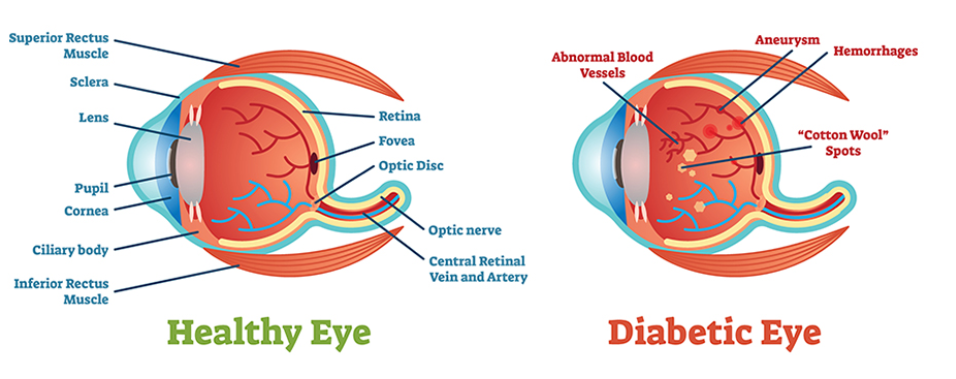Diabetic Retinopathy
Diabetes is a type of chronic disease; it occurs when the glucose level in the blood is higher than normal. It is one of the leading causes of heart problems as well. In Malaysia, according to the National Health Morbidity Survey (NHMS) 2019, there are about 3.9 million people aged 18 years and older who have diabetes. Diabetes affects one out of every five adults, and the prevalence is higher in states such as Negeri Sembilan (33.2%), Perlis (32.6%), and Pahang (25.7%). The prevalence of people who have undiagnosed diabetes in Malaysia is high as well; undiagnosed diabetes occurs when people have never checked their blood glucose level in their entire life or check it rarely (1).
To understand diabetes better, it occurs when the pancreas in the body does not produce enough insulin anymore, or when the insulin is not working well anymore. Insulin is needed in order to transport glucose from the blood vessels to cells and tissues. When insulin is insufficient, glucose cannot be transported to the intended organ, thus causing a high glucose level in the blood vessels and causing damage to the organ and tissue that do not get sufficient glucose to function, and also causing damage to the blood vessels that are exposed to a high glucose level (2).
There are various complications due to diabetes, such as kidney problems, heart problems, diabetic food disease, nerve problems, and eye problems. A nerve problem is when a diabetic person starts to feel tingling and numbness in their peripherals (legs and hands), which is commonly referred to as diabetic neuropathy. Diabetic foot disease, or gangrene, occurs when a diabetic person is exposed to a wound. It must be handled with care since it can be dangerous to the extent of amputation. Eyes problem or diabetes retinopathy is the one that can lead to blindness, that we are going to discuss in detail in this article (2,3).

Diabetes retinopathy is the condition in which the retina is damaged, and it is a diabetic complication. When the glucose level in the blood is high, it causes a blockage in the blood vessels, causing the blood vessels to rupture easily. thus causing impaired vision and blindness (2, 3).
In the early stages, there are no significant symptoms associated with this problem; however, as things get more serious, people will experience seeing floaters or black dots in their vision. They will then start to experience obscure vision, night blindness, and diplopia (seeing a double image) (2, 3).
Risk factor to this problem includes those who have been diagnosed with diabetic in the long time (more than 5 years), those who have poor control of blood glucose level, cholesterol level, blood pressure level and low haemoglobin. Those who have gestational diabetes are also at high risk of getting diabetes retinopathy (2, 3).
There are two types of diabetic retinopathy (2,4);
Non – Proliferative Diabetic Retinopathy
Non-proliferative diabetic retinopathy (NPDR) is the early stage of the disease, in which symptoms will be mild or non-existent. In NPDR, the blood vessels in the retina are weakened. Tiny bulges in the blood vessels, called microaneurysms, may leak fluid into the retina. This leakage may lead to swelling of the macula.
Proliferative Diabetic Retinopathy
The more advanced form of the disease is proliferative diabetic retinopathy (PDR). Circulation issues deprive the retina of oxygen at this stage. As a result, new, vulnerable blood vessels can form in the retina and the vitreous, the gel-like fluid that fills the back of the eye. Blood from the new blood vessels may leak into the vitreous, clouding vision.
In order to prevent diabetic retinopathy from occurring, it is recommended for individuals with diabetes to control their blood sugar level, control their blood pressure level, stop smoking, regularly exercise, and maintain their ideal weight. Apart from these, people with diabetes may as well conduct yearly eye screenings. Eye screening for diabetics will be conducted using a fundus non-mydriatic camera, where an image of the eyes will be captured. Optometrist, eyes doctor, or eye specialist will then grade the image to see whether the eye's codition is normal or abnormal. Bleeding and swelling in the retina, an abnormal optic disk, a torn retina, and other abnormal conditions are examples of abnormal conditions.
References
- National Health Morbidity Survey (NHMS) 2019. Institute Kesihatan Umum (IKU), Kementerian Kesihatan Malaysia.
- Fatanah Ismail. Diabetes Mellitus (2008). MyHealth Portal. Kementerian Kesihatan Malaysia. http://www.myhealth.gov.my/en/diabetes-mellitus-3/ (Accessed on August 21, 2020).
- Ainayanti Adnan. Diabetis: Mesti Jalani Pemeriksaan Mata (2016). MyHealth Portal. Kementerian Kesihatan Malaysia. http://www.myhealth.gov.my/diabetes-mesti-jalani-pemeriksaan-mata/ (Accessed on August 21, 2020).
- Diabetic Retinopathy (n.d). American Optometric Association (AOA). https://www.aoa.org/healthy-eyes/eye-and-vision-conditions/diabetic-retinopathy?sso=y (Accessed on August 21, 2020).




